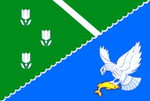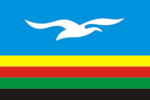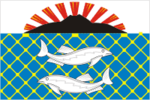 | |
| Proportion | 2:3 |
|---|---|
| Adopted | 28 November 1995 |
| Design | White silhouette of Sakhalin Island and Kuril Islands on a faded turquoise field |
| Designed by | Vitaliy Evgenievich Gomilevsky |
The flag of Sakhalin Oblast features a white silhouette of Sakhalin Island and the Kuril Islands on a faded turquoise field. [1] It was adopted on 28 November 1995.

















